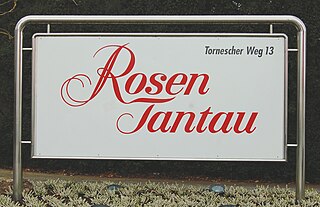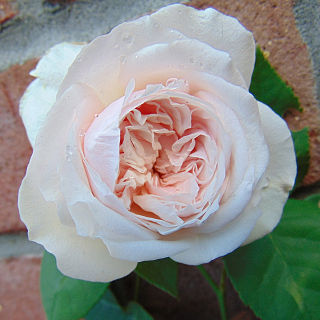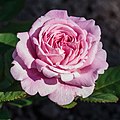
Rosa 'Ispahan', also known as 'Rose d'Ispahan' and 'Pompon des Princes', is a clear pink, half-open kind of Damask rose, a type of garden rose introduced from the Middle East to Europe during the crusading 13th century. Its origin is unclear – it was introduced in the UK by the garden designer Norah Lindsay (1873–1948), but was probably developed in the early 19th century – probably in Persia. The cultivar is named 'Ispahan' after the city Isfahan in Iran, renowned for its gardens and roses, where the cultivar was apparently discovered in a garden.

The Royal William rose, registered under the cultivar name 'KORzaun', is a red hybrid tea rose. It was developed by Reimer Kordes from the cultivar 'Feuerzauber' and is available under several other marketing names, such as Fragrant Charm, Duftzauber, La Magie du Parfum and Leonora Christine.

The Peace rose, formally Rosa 'Madame A. Meilland', is a well-known and successful garden rose. By 1992, over one hundred million plants of this hybrid tea had been sold. The cultivar has large flowers of a light yellow to cream color, slightly flushed at the petal edges with crimson-pink. It is hardy and vigorous and relatively resistant to disease, making it popular in gardens as well as in the floral trade.

Rosa 'Général Jacqueminot', also called 'General Jack' or 'Jack Rose', is an early Hybrid Perpetual rose cultivar, developed by Roussel, an amateur from Meudon, and introduced by the gardener Rousselet in 1853. The flower was named in honor of Jean-François Jacqueminot (1787-1865), a French general of the Napoleonic Wars. Its parentage is unclear, but 'Gloire des Rosomanes' and 'Géant des Batailles' are considered probable ancestors.

Rosa'Veilchenblau' is a mauve hybrid multiflora rose cultivar and the best known violet rambler. Other names are 'Bleu-Violet', 'Blue Rambler', 'Blue Rosalie' and 'Violet Blue'.

Rosen Tantau is a rose breeding company located at Uetersen, in the District of Pinneberg in Schleswig-Holstein, Germany.

Rosa 'Mrs. Harkness' is a rare light pink rose cultivar discovered by George Paul in Great Britain in 1893. It is a sport of the deep pink hybrid perpetual 'Heinrich Schultheis', introduced by Henry Bennet in 1882. The RHS Encyclopedia of Roses lists 'Paul's Early Blush' and 'Mrs Harkness' as two separate sports of 'Heinrich Schultheis', while Peter Beales uses the names synonymously.

The Europa-Rosarium, formerly the Rosarium Sangerhausen, is a municipal rose garden located in Sangerhausen, Saxony-Anhalt, Germany. With 8300 cultivars and species it is one of the largest rose collection in the world, playing an important role as budwood source and in research. In 2003 it was granted the Award of Garden Excellence by the World Federation of Rose Societies.

Rosa 'Eden' is a light pink and white climbing rose. The cultivar was created by Marie-Louise Meilland and introduced in France by Meilland International in 1985 as part of the Renaissance® Collection. It was named 'Pierre de Ronsard', after the French Renaissance poet Pierre de Ronsard in reference to his famous ode that begins: Mignonne, allons voir si la rose. The cultivar is also called 'Eden Rose 85' as Meilland had already introduced a rose cultivar called 'Eden' in the 1950s.

Rosa'Camp David' is a red hybrid tea rose developed by Mathias Tantau, Jr. in 1984.

Rosa 'Garden Party' is an ivory hybrid tea rose cultivar created by Herbert C. Swim in 1959. Its parents are the hybrid teas 'Charlotte Armstrong' and 'Peace'.

Rosa 'Old Blush', also known as 'Parsons' Pink China', 'Old Blush China', 'Old China Monthly', is a China rose and has been cultivated in China for over a thousand years. It derives from Rosa chinensis, and is generally accepted as the first East Asian rose cultivar to reach Europe. It is recorded in Sweden in 1752 and in England before 1759, but was probably cultivated in China for several centuries. It is believed to be the rose which inspired the song The Last Rose of Summer by the Irish composer and poet Thomas Moore. It is also known as Parsons' Pink China, named after Mr Parson who introduced it commercially to the UK in 1793.

Rosa 'Nevada' is a white rose cultivar developed by Pedro Dot in Spain in 1927. It is one of his most successful creations and is named for its colour, as nevada is the Spanish word for "snowy". Its parentage was long under discussion, as Dot introduced the cultivar as a hybrid moyesii, but the cultivar's round, black hips point to its R. pimpinellifolia-parentage. It is probably a cross between Dot's pink hybrid tea 'La Giralda' and the wild rose species Rosa pimpinellifolia var. altaica, but is sometimes still described as a hybrid moyesii.

Rosa 'Wife of Bath', also known as 'Rosarium Glücksburg', 'Glücksburg', AUSwife or 'AUSbath', is a common pink rose cultivar developed by David C.H. Austin in England in 1969. It was one of his early cultivars and is named after a character from Geoffrey Chaucer's The Canterbury Tales. 'Rosarium Glücksburg' is a rose garden in the park of Schloss Glücksburg in Glücksburg, Germany.

Rosa 'Albéric Barbier' is a popular rambling rose cultivar that was bred in 1900 by Barbier Frères & Compagnie. Its parents were R. wichuraiana and the yellow hybrid tea 'Shirley Hibberd', named after the Victorian gardening writer (1825–1890).

Rosa 'Elina' is a light yellow hybrid tea rose bred by Patrick Dickson of Northern Ireland in 1983. The variety was developed from the white floribunda 'Nana Mouskouri' and the apricot hybrid tea 'Lolita'.

Rosa 'Duchess of Cornwall' is an orange blend rose cultivar bred by Hans Jürgen Evers from Rosen Tantau in Germany and introduced in 2005. The nostalgic hybrid tea rose is known as 'Music Hall' in France, and as 'Chippendale' in Germany. According to Robert Markley, it is already one of Tantau's most successful roses.

Rosa 'Blush Noisette' is a light pink Noisette rose introduced by Phillipe Noisette around 1815. It was one of the first Noisette roses, and over time has been called by a multitude of names, including Rosa × noisettiana, 'Rosier de Philippe Noisette', 'Noisette de l'Inde, 'Blush Cluster', or 'Noisette Carnée'. According to the RHS Encyclopedia of Roses, the cultivar is mostly called 'Blush Noisette' in America, and otherwise known as 'Noisette Carnée'. 'Blush Noisette' arose as a seedling from the light pink rose hybrid 'Champney's Pink Cluster', introduced by Champneys around 1811, and was the first frost-hardy climber flowering repeatedly, giving the cultivar importance as a parent rose.

Rosa'Souvenir de la Malmaison' is a rose cultivar with large, very pale pink, flowers that open flat. The Bourbon rose was created in 1843 by Lyon rose breeder Jean Béluze, who named it after the Château de Malmaison, where Joséphine de Beauharnais (1763–1814) had created a magnificent rose garden. It is probably a cross between 'Mme Desprez' and 'Devoniensis'.



























